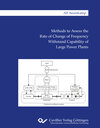Methods to Assess the Rate of Change of Frequency Withstand Capability of Large Power Plants
von Alf AssenkampSchwere Fehler in elektrischen Netzen mit einem hohen Anteil an umrichtergestützter Einspeisung, z. B. aus Windparks und Photovoltaikanlagen, führen ohne zusätzliche Netzstützungsmaßnahmen zu erhöhten Frequenzänderungsraten (ROCOF). Folglich erhöhen Übertragungsnetzbetreiber ROCOF-Werte, denen die Generatoren standhalten müssen. Dies ist aus Sicht der Systemstabilität wichtig, stellt aber eine große Herausforderung für Synchronmaschinen dar. Bislang wurden hauptsächlich Fehler wie Fehlsynchronisierungen oder klemmennahe Kurzschlüsse bei konstanter Netzfrequenz für die Auslegung großer Synchronmaschinen betrachtet. Das Problem ist, dass es entsprechend noch keine Methoden zur zuverlässigen und reproduzierbaren Beurteilung der Widerstandsfähigkeit von Synchronmaschinen gegenüber hohen Frequenzänderungsraten gibt. Im Rahmen dieser Arbeit werden daher Methodiken entwickelt für den Aufbau der Netzmodelle für ROCOF-Studien, für die Untersuchung der Fähigkeit von Synchrongeneratoren, bei Ereignissen mit hohen ROCOF-Raten mit dem Netz synchronisiert zu bleiben, und für die Untersuchung der mechanischen ROCOF-Widerstandsfähigkeit von Synchronmaschinen. Die Methodiken werden anhand von Beispielstudien validiert und anschaulich dargestellt.
Severe faults in electrical networks with a high proportion of inverter-supported feed-in, e. g. from wind farms and photovoltaic systems, lead to increased rates of change of frequency (ROCOF), if no additional frequency support measures are installed. As a result, transmission system operators increase ROCOF values that the generators must withstand. This is important from the point of view of system stability, but represents a major challenge for synchronous machines. So far, faults such as fault synchronisation or short circuits close to the terminals at a constant mains frequency have mainly been considered for the design of large synchronous machines. The problem is that, accordingly, there are still no methods for reliable and reproducible assessment of the resistance of synchronous machines to high ROCOF. In the context of this work, methodologies are therefore developed for setting up power system models for ROCOF studies, for the investigation of the ability of synchronous generators to remain synchronized with the network during events with high ROCOF rates, and for the investigation of the mechanical ROCOF withstand capability of synchronous machines. The methodologies are validated and illustrated by means of sample studies.
Severe faults in electrical networks with a high proportion of inverter-supported feed-in, e. g. from wind farms and photovoltaic systems, lead to increased rates of change of frequency (ROCOF), if no additional frequency support measures are installed. As a result, transmission system operators increase ROCOF values that the generators must withstand. This is important from the point of view of system stability, but represents a major challenge for synchronous machines. So far, faults such as fault synchronisation or short circuits close to the terminals at a constant mains frequency have mainly been considered for the design of large synchronous machines. The problem is that, accordingly, there are still no methods for reliable and reproducible assessment of the resistance of synchronous machines to high ROCOF. In the context of this work, methodologies are therefore developed for setting up power system models for ROCOF studies, for the investigation of the ability of synchronous generators to remain synchronized with the network during events with high ROCOF rates, and for the investigation of the mechanical ROCOF withstand capability of synchronous machines. The methodologies are validated and illustrated by means of sample studies.







